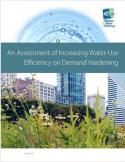Research Report on Water-Use Efficiency and Demand Hardening

A research report assessing the impacts of increasing water-use efficiency on demand hardening. Funded by a number of water utilities and The Walton Family Foundation, the report discusses whether consumer demand can be “hardened” by the continued pressure of demand management programs. The report was prepared by Anil Bamezai, PhD, of Western Policy Research under the direction of the Alliance for Water Efficiency and a project committee composed of water utilities that provided data for analysis.
Description of the Project
Water suppliers have promoted conservation programs very vigorously over the last two decades. Some have cautioned that investments in long‐term conservation programs will make achieving demand reductions more difficult during periods of extended shortage since there will be less discretionary use for the customer to cut back. Water conservation professionals call this effect demand hardening.
This study was undertaken to fulfill two broad missions: First, to clarify what demand hardening means, and more importantly, what it does not; Second, to offer ideas for how to go about mitigating and managing the effects of potential demand hardening through better crafted and implemented water shortage contingency plans.
Because prior published literature on demand hardening remains meager, this study attempts a fairly comprehensive, rigorous examination of the issues involved by focusing on the historical shortage experience of seven water suppliers (case studies) located throughout the arid Southwestern United States. These include the City of Boulder, Colorado; City of Santa Fe, New Mexico; San Antonio Water System, Texas; and four suppliers from California (from the north, City of Petaluma and City of Santa Rosa, from the south, Monte Vista Water District and Irvine Ranch Water District). These suppliers, being located in drought‐prone regions of the United States, and also having invested significantly in water‐use efficiency over many years, were chosen as interesting test cases for the proposition that rising water‐use efficiency may make dealing with extended periods of shortage more difficult.
Research Report General Findings
The report’s findings are based on the data gathered and analyzed from the seven water supplier case studies.
- How customers respond to shortages depends on the perceived severity of the shortage and on the vigor with which mandatory restrictions are enforced.
- There seems to be no clear relationship between average per-capita demand just prior to the shortage and the percent reduction in demand that is achieved during the following shortage.
- Residential customers appear to retain considerable ability to change their indoor water-using behavior, and with the significant amount of water still being used outdoors, customers can significantly reduce their total demand by making steep cuts in outdoor water use as well.
- There is no reason to believe that ability for making time-limited adjustments in behavior is any less now than in the past. Cutting outdoor water use broadly -- specifically irrigation -- will remain the first priority for adapting to imminent shortages.
- As irrigation becomes a smaller component of total demand, water shortage contingency plans will need to target indoor water use much sooner in a shortage cycle than in the past.
- The best water shortage contingency plans, however, require customer cooperation to succeed. Managing customer willingness to cut demand during shortages is the key to preventing demand hardening. Customers seem most hungry for information about how to improve outdoor water-use efficiency and how to keep their water bills low. Water suppliers need to do more about educating their customers that conservation also improves supply reliability, if customers have the mistaken belief that conservation only fuels new growth or that conservation just makes their water bills higher.
- Compliance with mandatory restrictions may improve if customers both understand and trust their supplier’s long-term water supply plan and also understand why the infrequent use of drought restrictions is ultimately in their own interest.
- Water resource planners must continue to study the relative efficacy of differently configured water shortage contingency plans to isolate which features work better than others in their area and not rely on generic water shortage contingency plans. Test whether savings expectations at each trigger point in a water shortage contingency plan can actually be achieved. Regularly update water shortage contingency plans and associated enforcement mechanisms to favor curtailment strategies that both minimize economic costs and are consistent with the changing mix of discretionary and non-discretionary uses of water.





